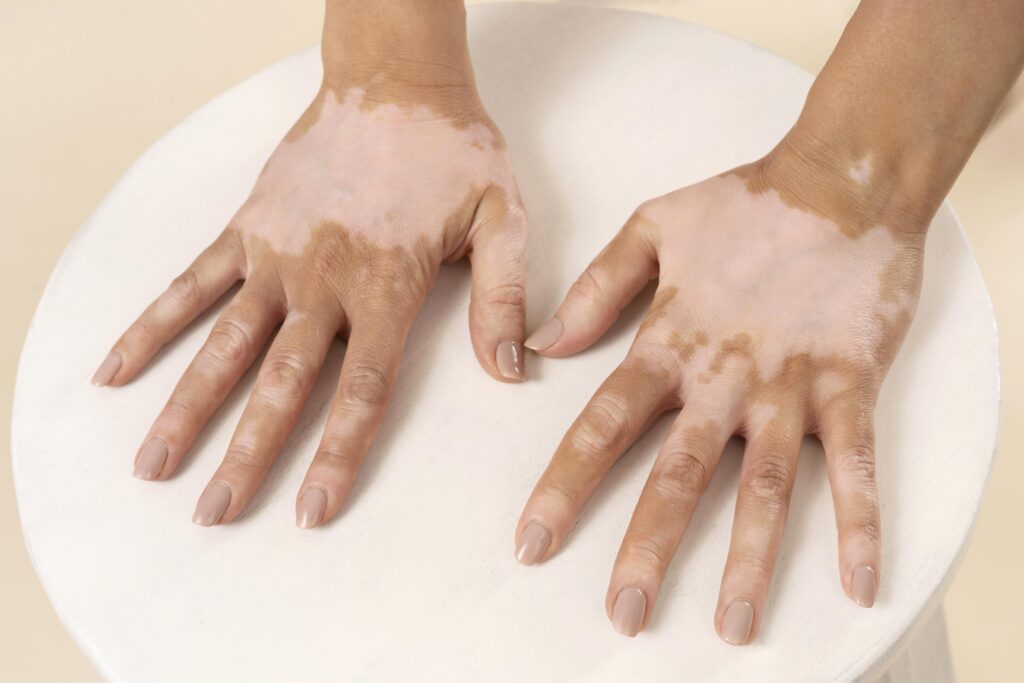Last updated on April 19th, 2025 at 11:13 am

Vitiligo Treatment – Vitiligo is a skin condition characterized by the loss of pigment-producing cells (melanocytes), resulting in white patches on the skin. While it’s not a life-threatening condition, it can have a significant impact on a person’s self-esteem and quality of life. Fortunately, there are several vitiligo treatment options available that can help manage it and improve the appearance of the skin.
Medical Vitiligo Treatment
Medical vitiligo treatments aim to either repigment the white patches or prevent the spread of the condition. Here are some used medical treatments:
a) Topical Corticosteroids: These are anti-inflammatory creams or ointments that can help reduce inflammation and promote repigmentation. They are often the first-line vitiligo treatment option.
b) Topical Calcineurin Inhibitors: These drugs, such as tacrolimus and pimecrolimus, work by suppressing the immune response in the skin and can be used on sensitive areas like the face and genitals.
c) Psoralen Plus Ultraviolet A (PUVA) Therapy: PUVA therapy involves taking psoralen, a medication that makes the skin more sensitive to ultraviolet A (UVA) light, followed by exposure to UVA light. This combination stimulates melanocyte activity and repigmentation.
Read: What are Generic Medicines?
d) Narrowband Ultraviolet B (NB-UVB) Therapy: NB-UVB therapy uses a specific wavelength of ultraviolet light to stimulate melanocytes in the skin and promote repigmentation.
e) Excimer Laser: This targeted laser therapy can be used to treat smaller areas of vitiligo, delivering high-energy UVB light to stimulate melanocyte production.
f) Oral Medications: In some cases, oral medications like corticosteroids or immunosuppressants may be prescribed to manage vitiligo, especially if it’s widespread.

Surgical Vitiligo Treatment
When medical treatments don’t provide the desired results, surgical options may be considered. These procedures involve transplanting melanocytes or pigment from one part of the body to the affected areas. Some common surgical for vitiligo treatments include:
a) Autologous Melanocyte Transplantation: In this procedure, melanocytes are harvested from a patient’s skin, cultured in a lab, and then transplanted onto the depigmented areas.
b) Microskin Grafting: This involves removing small sections of normally pigmented skin and grafting them onto vitiligo-affected areas.
c) Tattooing (Micropigmentation): Tattooing can be used to implant pigment into the depigmented skin, creating a more consistent and even appearance.
> Consult a doctor and Order Medicine Online
Complementary and Alternative Therapies Vitiligo Treatment
In addition to medical and surgical treatments, some individuals with vitiligo turn to complementary therapies to manage their condition. Some of these therapies include:
a) Topical Herbal Remedies: Some natural products, such as khellin or ginger extract, have been explored for their potential to repigment the skin.
b) Diet and Nutrition: Certain diets rich in antioxidants, vitamins, and minerals may help support melanocyte health. Additionally, some individuals with vitiligo try gluten-free or dairy-free diets, as there is anecdotal evidence of symptom improvement.
c) Psychological Support: Living with vitiligo can be emotionally challenging. Counselling and support groups can help individuals cope with the psychological impact of the condition.
Vitiligo Treatment Creams
Vitiligo treatment creams, also known as topical medications, are a common choice for managing this skin disorder. These creams are applied directly to the affected areas, where they work to stimulate melanocyte activity and promote repigmentation. The key components of these creams include:
- Corticosteroids: Topical corticosteroids are anti-inflammatory agents that help reduce inflammation in the skin and suppress the immune response that attacks melanocytes. These creams are often prescribed as a first-line treatment for vitiligo.
- Calcineurin Inhibitors: Topical calcineurin inhibitors, such as tacrolimus and pimecrolimus, are used to inhibit the immune system’s response in the skin, ultimately preventing the further spread of vitiligo and promoting repigmentation.
- Psoralen: Psoralen-containing creams are often used in combination with UVA or sunlight exposure, a treatment approach known as PUVA therapy. Psoralen makes the skin more sensitive to UVA light, allowing for targeted repigmentation.
Effectiveness of Vitiligo Treatment Creams
The effectiveness of vitiligo treatment creams varies from person to person and depends on several factors, including the extent of vitiligo, the location of the white patches, and the individual’s response to treatment.
Conclusion:
Vitiligo treatment options vary depending on the extent and severity of the condition. Individuals with vitiligo need to consult a dermatologist who can assess their specific situation and recommend the most appropriate treatment plan. While there is no cure for vitiligo, medical, surgical, and complementary therapies can help manage the condition, improve skin appearance, and enhance the quality of life for those affected. Ultimately, the goal of vitiligo treatment is to empower individuals to embrace their unique beauty and feel confident in their skin.
FAQs on Vitiligo Treatment
Q.1 What is Vitiligo Treatment?
Vitiligo treatment refers to a set of medical, surgical, and sometimes complementary therapies aimed at managing and improving the skin condition known as vitiligo. Vitiligo is characterized by the loss of melanocytes (the cells responsible for producing skin pigment), resulting in white or depigmented patches on the skin. The primary goal of vitiligo treatment is to either repigment the affected areas or prevent the condition from spreading further.
Q2. Are there any surgical options available for vitiligo treatment?
Yes, there are surgical treatments for vitiligo when medical therapies do not yield satisfactory results. Surgical options include autologous melanocyte transplantation, where melanocytes are harvested from the patient’s skin, cultured, and then transplanted onto depigmented areas.
Microskin grafting, which involves transplanting small sections of normally pigmented skin to vitiligo-affected areas. Tattooing (micro pigmentation), where pigment is implanted into the depigmented skin to create a more consistent appearance. These surgical procedures are typically considered for localized or stubborn cases of vitiligo.